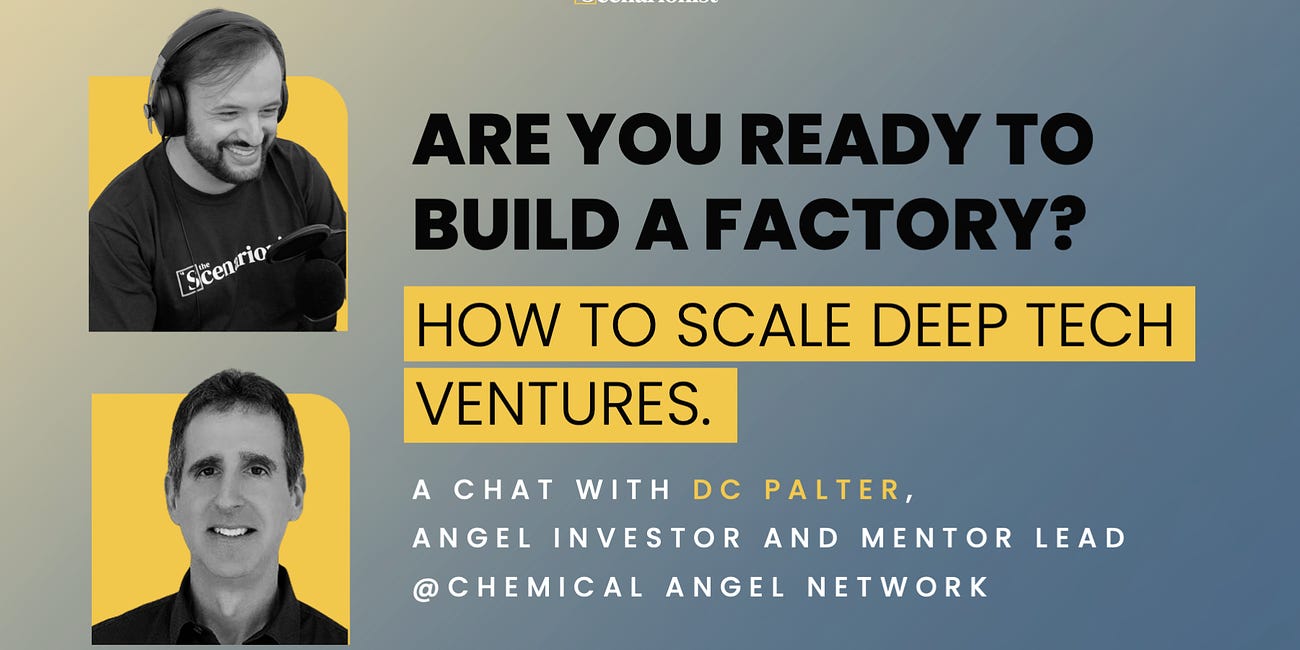Dive into the essentials of Deep Tech Startups with our expert guest, Swati Chaturvedi, Co-founder and CEO of Propel(x), and the pioneer who coined the term 'Deep Tech' in 2015.
🎧 Prefer to listen?
🤔 What is Deep Tech?
Let's explore the definition and unique characteristics of Deep Tech startups and technologies.
"Deep Tech" refers to startups and technologies that are based on significant scientific or engineering breakthroughs. These startups typically leverage advancements in fields like biotechnology, artificial intelligence, nanotechnology, and more to develop innovative solutions to complex problems.
In detail, Deep Tech stands apart from other startup sectors due to its heavy reliance on cutting-edge science and technology. Unlike many traditional tech startups that focus on software and apps, Deep Tech startups often involve complex physical products or technologies with longer development timelines. They aim to tackle some of the world's most challenging issues, making them unique in their approach and potential impact.
👉🏻 Customer > Tech
Scientific researchers often believe they have an investable company, but a critical element is missing: customer interaction.
This is common, especially in early-stage companies, and it's not a deal-breaker. However, it's crucial for entrepreneurs to initiate conversations with potential customers.
For instance, if you have developed a new material technology, it's essential to identify its practical applications. This could range from use in battery systems to medical devices, spanning various industries.
The key for entrepreneurs is to find a practical use case. Even if a market seems large or small, having a prospective customer makes a significant difference. It's about doing the manageable tasks first - talking to customers, gathering feedback, and understanding their needs. This feedback will reveal that the material technology alone isn't enough; you need to develop a complete product with all the necessary components.
Engaging with customers helps shape the product. Once you have a design based on one customer's feedback, you can validate and refine it with other potential customers. This iterative process often leads to signing a letter of intent (LOI) or a memorandum of understanding (MOU), indicating their interest in your product.
This stage marks the transition from a concept to a company with a clear product and known customer base. It's also the point when capital becomes necessary to develop and deliver the product. Before fundraising, having customer engagement and a defined product prototype significantly enhances your appeal to investors.
❗️ Problem > Tech
There's a common misconception among scientists that investors may not grasp their technology. However, the issue often lies in communication, not comprehension. It's essential to explain complex ideas in simple terms.
Remember, the technology itself is not the primary focus for investors; the problem you're solving is. Lead with the issue, then introduce your unique solution and proprietary technology.
🗣 Communication > Tech
When discussing technology, simplify your explanation. For example, in the context of battery technology, you don't need to delve into the intricate chemistry. Instead, focus on how your technology is unique, such as cost-effectiveness or efficiency compared to existing solutions. This approach is more likely to resonate with investors.
3 main points to recap
In summary, for entrepreneurs, especially those from scientific backgrounds, the journey to an investable company involves more than just groundbreaking technology. It requires customer engagement, a clear understanding of the market, and effective communication of how your innovation addresses a significant problem.
Let’s recap the importance of balancing technology with marketability for startup success in 3 main points:
Cutting-Edge Tech and Success: Having cutting-edge technology alone doesn't guarantee a successful product because success depends on more than just technology. It also involves addressing a real market need, effective marketing, and a viable business model.
Right Time for STEM Entrepreneurs to Approach Investors: STEM entrepreneurs should approach their first investor after they've engaged potential customers, gathered feedback, and developed a clear understanding of their product-market fit. Investors are more interested when there's a defined product, customer conversations, and a clear path to market.
Significance of a Viable Use Case: A viable use case is significant because it demonstrates that there's a real demand for your technology. It differentiates an investable company from a research project by showing that your technology solves a specific problem and has the potential to generate revenue or attract investors.
👀 5 tips to communicate your entrepreneurial vision to investors
Investors don't necessarily need to grasp the intricate technical details of your technology from the outset. Instead, focus on conveying the problem your technology solves and why it's crucial. Highlight your unique approach to addressing this problem, which is where your proprietary technology comes into play.
You can simplify your explanation by categorizing your technology within a broader domain. For example, in the context of battery technology, you don't need to delve into the exact chemistry with every investor. Instead, mention that your technology falls within a specific category and outline a few key advantages, such as lower costs or improved performance. Investors are primarily interested in the problem you solve and your potential to disrupt the market.
Here are 5 suggestions:
Essentials in Pitching Venture Ideas: When pitching venture ideas, it's essential to highlight the significance of the problem your technology addresses, explain how your solution stands out, demonstrate market demand, and emphasize your team's expertise.
Articulating Entrepreneurial Vision: To articulate your entrepreneurial vision, focus on the problem's importance, your unique solution, and the potential market impact. Keep it concise and compelling, showing how your vision can solve real-world challenges.
Build Compelling Pitch Decks: Create a pitch deck that tells a story, starting with the problem, introducing your solution's unique value, highlighting team expertise, and showcasing market demand. Use visuals, keep it concise, and practice your pitch for clarity.
Investor Priorities: Investors prioritize several factors, including the significance of the problem you're addressing, the potential market size, your team's capabilities, and the uniqueness of your technology. They also want to see a clear path to revenue or an exit strategy.
Technology Matters, The Problem Matters Most: From an investment standpoint, the issue your technology addresses is often more crucial than the technology itself. Investors seek startups that can make a significant impact by solving pressing problems, with technology being a means to that end.
🧗♀️ Before Becoming Revenue-Positive Mitigate The Risks With The Strategy
Deep tech startups often face the challenge of a long time to revenue, which is their primary risk. To mitigate it, consider two primary exit strategies: acquisition and revenue generation.
Acquisition: Many deep tech startups get acquired before generating any revenue. For example, in the medical device or pharmaceutical sector, companies are often acquired after completing phase two clinical trials, well before generating revenue. This route allows you to monetize your innovation without reaching the revenue stage.
Revenue Generation: Alternatively, you can aim to generate revenue directly. However, this typically requires navigating regulatory hurdles, such as FDA approvals, and building sales and marketing capabilities. Consider whether your technology aligns with the revenue generation approach or is better suited for acquisition.
5 dimensions that founders should consider in this case:
Time to Money vs. Time to Exit: "Time to Money" focuses on when a Deep Tech startup can start generating revenue or achieve an exit, emphasizing the importance of financial viability. It shifts the emphasis from exit strategies to revenue generation. Understanding "Time to Money" is crucial because it highlights the need for startups to sustain themselves financially, either through revenue or exits, which is vital for their survival and investor appeal.
Estimating Timeframe: Founders can estimate this timeframe by analyzing industry standards, studying similar startups' journeys, and considering their technology's development stage. Regular market research and staying updated on industry trends also help.
Look for Common Exits: A common exit for Deep Tech startups is an acquisition by larger companies in related industries. They often acquire startups for their innovative technologies and intellectual property.
Investment Perspective: From an investment perspective, a sound exit strategy assures investors that there's a plan in place to realize returns on their investment. It reduces uncertainty and enhances a startup's appeal to potential investors.
Long-Term Projection: Founders can project their Deep Tech enterprise's long-term journey by continuously engaging with potential customers, staying adaptable to market shifts, and considering potential acquirers in their industry. Building a roadmap that outlines milestones and growth strategies can also help.
🤼 3 Actionable Tips to Approach Market Sizing
Scientists venturing into the business world should start by narrowing their focus. Instead of examining the entire Deep Tech sector, look for companies and transactions that closely resemble your own technology or solution. Seek out comparable metrics within your specific niche or subfield.
For instance, if you're working on battery technology, explore other companies working on similar battery technologies, even if they serve different applications. Look for transactions that mirror your technology and its potential. Comparable companies are often the best starting point for estimating market size and valuing your startup.
Here are 3 takeaways:
Industry Metrics: Scientific founders should immerse themselves in industry-specific metrics and data. This includes understanding the dynamics, trends, and challenges within their specific sector.
Determining Market Size: To determine market size, founders can begin by defining their target market segment. They should analyze available data, conduct surveys, and gather insights from potential customers. It's crucial to focus on the specific niche their technology addresses.
Identifying Comparables: Scientific founders should look for comparable companies within their niche. These comparables can provide valuable insights into market dynamics, valuations, and potential exit scenarios.
Comparable investment transactions within a sector are pivotal for investors because they offer a reference point for evaluating the potential of a startup. Investors often assess a startup's value by comparing it to similar companies that have gone through funding rounds or acquisitions. It helps them gauge the startup's potential for growth and return on investment.
🍰 How to Approach Your Startup’s Valuation
The initial valuation for a Deep Tech startup is often based on what peers in your industry and subfield are achieving, both in terms of funding and market penetration. This approach helps you gauge your startup's potential value more accurately.
When it comes to understanding a company's early valuation, founders should consider several key factors:
Starting Point: Founders can begin by assessing what similar startups in their industry and stage are raising in terms of valuation. This provides a starting point for understanding where their company might fit within the market.
Equity and Fundraising Goals: There's an interplay between relinquishing equity and meeting fundraising goals. Founders need to strike a balance between how much equity they are willing to give up and the amount of capital they need to raise. Typically, in the seed stage, founders may give up around 20-25% of their company to secure the necessary funding. This percentage can vary, but it provides a guideline for founders to determine their pre- and post-money valuations.
This is all for today!
Wanna be more involved?
👉🏻 Follow our LinkedIn page and drop a DM!
👉🏻 Write us a line here: info@thescenarionist.org
See you next week! 👋























